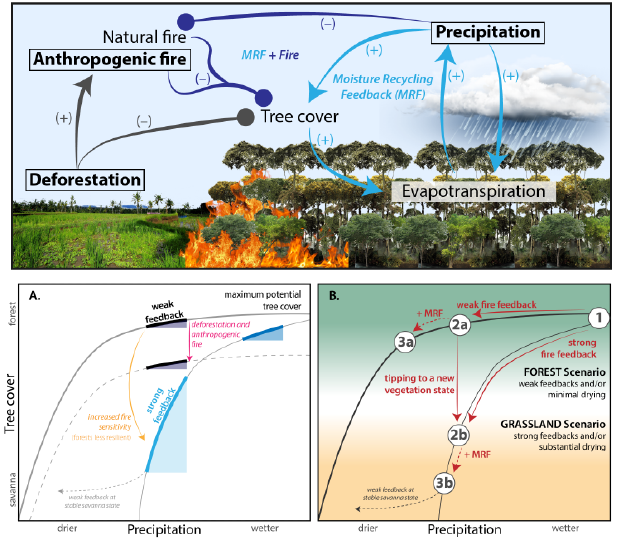
Amazon rainfall-rainforest dynamics
(The Amazon River; MODIS, July 29, 2020)
How resilient is the Amazon Rainforest to climate?
Amazonia has likely been forested for tens of millions of years, begging the question: is tree cover resilient to climate change, or has Amazon climate change been pretty minimal? Most paleoclimate reconstructions are qualitative (i.e. answering “warmer” or “drier” but not “how much”) so quantifying the resilience of Amazon vegetation has been challenging. My work uses paleo -climate and -environment data with numerical models to constrain (1) the drivers and magnitude of hydroclimate change and (2) the strength of internal feedbacks that affect tree cover (like moisture recycling and fire).
Kukla et al., (2023) “The zonal patterns in late Quaternary Tropical South American precipitation”. Paleoceanography and Paleoclimatology.
Kukla et al., (2021). “The resilience of Amazon tree cover to past and present drying”. Global and Planetary Change.
Hoorn, Kukla, et al., (2021) “Cyclic sediment deposition by orbital forcing in the Miocene wetland of western Amazonia? New insights from a multidisciplinary approach”. Global and Planetary Change.
-

How does tree cover respond to climate?
The strength of internal feedbacks and external forcings affects tree cover resilience. However, distinguishing the relative contribution of feedbacks and forcings to a vegetation response is not straightforward. In Kukla et al., 2021, we constrain the strength of feedbacks that threaten tree cover by quantifying paleo-precipitation and tree cover. If feedbacks are strong, tree cover is more sensitive to precipitation; if weak, less sensitive.
-

Mid-Holocene tree cover was resilient to drying
Our proxy-derived precipitation and tree cover estimates are supported by Dynamic Global Vegetation Model (DGVM) simulations indicating high tree cover at low precipitation. Abrupt forest dieback due to strong internal feedbacks (like fire) is a concern when precipitation is below 2,000 mm/yr because this is the threshold for a dry-season water deficit. Our results suggest that a dry season water deficit does not necessarily initiate widespread dieback. While tree cover appears resilient to this 2,000 mm/yr threshold (in the absence of extensive human land use), crossing below this threshold may accelerate deforestation, which is easier with a seasonal water deficit (e.g. Staal et al., 2020).
-

What caused mid-Holocene drying?
It’s unclear. Some exciting work has successfully simulated the general oxygen isotope trends with isotope-enabled climate models (Cruz et al., 2009; Liu and Battisti, 2015). But the exact dynamical cause is debated, and there are still some discrepancies between observed oxygen isotope records and model-predictions. Our work is testing hypotheses about links to African climate (particularly over the Sahara) with proxy compilations, proxy-based models, and energy balance climate models.
-

Future Work: Cenozoic Amazonia
The Cenozoic history of Amazonia is thought to play a key role in its modern biodiversity. Our understanding of Amazon climate and biogeography in the Cenozoic, however, is mostly limited to sparse outcrops and often-exclusive industry drill cores. IODP Expedition 387 to the Amazon Margin will help fill the scientific drilling gap in Amazonia. As a science party member, I plan to develop constraints on Amazon Cenozoic hydroclimate and tectonics with triple-oxygen isotopes of clay minerals. I’m currently validating the triple-oxygen isotope system with clays from modern South American soils.